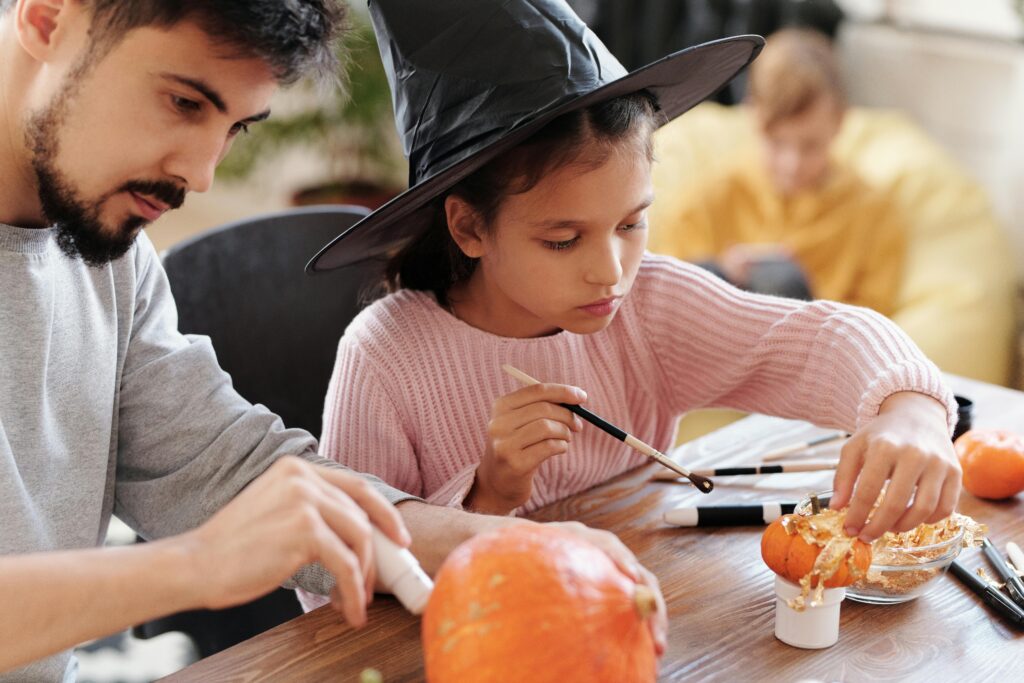Halloween has potential frights for any child, but for a young one grieving a death, the zombie movies, skeleton costumes, and tombstone decor may bring additional fears and sadness. Many cherished childhood memories are formed while trick-or-treating, but how can you keep it emotionally safe for your child? As a massive fall enthusiast, but big-time scaredy cat, I am well acquainted with ways to find the treats and leave behind the tricks.
6 ways to keep the “wee!” in Halloween:
1. Present kids with choices.
Let them know it’s an option to skip trick-or-treating, and that you wouldn’t be disappointed. Maybe it’s a family tradition, or they think getting the photos is important to you and they are embarrassed to ask to skip. If you notice that reminders of death are upsetting to them, consider providing alternatives; Do they want to trick-or-treat while the sun is still up; would they prefer a family movie night; could their friends have a costume sleepover/dance party in your living room? For kids who do want to trick or treat, assure them they have the choice to say they want to stop at any time. If they are out without you, and would be uncomfortable saying they were sad or scared to friends, remind them of the tummy or headache excuse they can provide.

If trick-or-treating feels too stressful, you and your child can plan fun and creative activities at home.
2. Do some prep work.
Things are often less scary in the light of day. Would it help to circle the neighborhood beforehand for them to see the decor in daytime? Homesick youth at Experience Camps found relief in having a few adults walk the perimeter of camp with them at night with flashlights. Earplugs are another crowd pleaser at camp. These, or noise canceling headphones, help reduce sensory overwhelm with sounds like screaming trick-or-treaters and spooky decor that yells. Would an upbeat music playlist help to have either in the car or on a small speaker if walking? Younger children may appreciate a comforting stuffed animal. Fidget toys serve to reduce anxiety, and sometimes we feel stronger with something in hand. My cousin quelled my fears at a childhood sleepover by giving me a drawing she made of a ghost with an “X” over it.
3. Allow space for processing.
Rather than the spooky decor, what scares most of us is being left alone. After the death of a parent, this fear is common. If you are present and allow space for them to share their feelings, that will be the greatest emotional safety you can provide. If something scared or made them sad trick-or-treating, encourage them to say why it affected them, rather than encouraging, “being brave” or brushing it aside as, “just a silly decoration.” After a rupture, the repair is where the healing happens; in being heard we can heal.
4. Use Halloween to improve coping skills.
Halloween is one day a year, but scares and reminders of death can come any time. Trick or Treating can be a practice run to try out new ways to calm their nervous system. If your child is open to learning, you can help teach them tips like 4,5,6 breathing (4 seconds inhaling through the nose, holding for 5 seconds, then 6 seconds of exhaling through the mouth while relaxing jaws and shoulders). Another way to decrease a racing heart is to repeat a mantra like, “I am strong” or, “I am safe.” A popular grounding practice is to name something you see for each color of the rainbow (ROYGBIV). These skills could also be test run while watching a spooky movie this season or reading (our fifth grade campers loved the Goosebumps novels).
5. Consider leaning into the season.
Rather than focusing on the gory side of Halloween, your family may find it right to use this season to remember and honor the deceased. In many cultures and religions, this season is a chance to clean the gravesites, prepare favorite meals of their beloved, and share stories from their life. The Mexican holiday of Dia De Los Muertos, The Christian observance of All Souls Day, and the Korean festival of Chuseok, all focus on staying connected beyond death and allowing room to discuss memories. Reflect on what is right for your family’s beliefs, as well as timing (this might be more comforting after a longer passage of time since the death).
6. Remember your own feelings.
Reminder that if your kid or teen is sad or scared on October 31st (or any of the other 364 days of the year), you did not fail as a parent. We grow through what we go through, and grief can come at any time. You can plan the perfect grief-free Halloween, and then Tuesday at the supermarket your child could cry at seeing their loved one’s favorite cereal. Grief has been called love persevering, and these emotional releases are natural for your child and for you.
Lastly, I want to ask: How are you? Sometimes we manage our anxiety by focusing on others’ emotions. If you are a parent reading this article, you probably are prioritizing how your family will feel this Halloween; but you may be forgetting that you matter too and deserve to be considered in making this a fun fall. If thinking of death-related reminders sounds upsetting, would you rather do a pumpkin patch/corn maze this season? If you need to sit out trick-or-treating, but your kids still want to go, is there a group of their friends or other family members who could take them? You also get to focus on your feelings and choose what works for you.
 Kat O’Malley (She/her), a Grief Specialist for Experience Camps, is an Associate Marriage and Family Therapist in Pasadena, California. She received her Master’s Degree in Psychology from Antioch with a specialization in LGBT+ Affirmative psychotherapy. Kat enjoys working with neurodivergent populations (autistic people & folks with ADHD), teens discovering their gender identities or sexual orientations, families processing grief, and any individual who is looking to return home to themself. Outside of work, Kat fills her days with crafting, swimming, hosting book club, visiting turtle ponds, and spending cherished time with her lizard Monterey Jax and seven guinea pig sons (six are hairless!).
Kat O’Malley (She/her), a Grief Specialist for Experience Camps, is an Associate Marriage and Family Therapist in Pasadena, California. She received her Master’s Degree in Psychology from Antioch with a specialization in LGBT+ Affirmative psychotherapy. Kat enjoys working with neurodivergent populations (autistic people & folks with ADHD), teens discovering their gender identities or sexual orientations, families processing grief, and any individual who is looking to return home to themself. Outside of work, Kat fills her days with crafting, swimming, hosting book club, visiting turtle ponds, and spending cherished time with her lizard Monterey Jax and seven guinea pig sons (six are hairless!).
